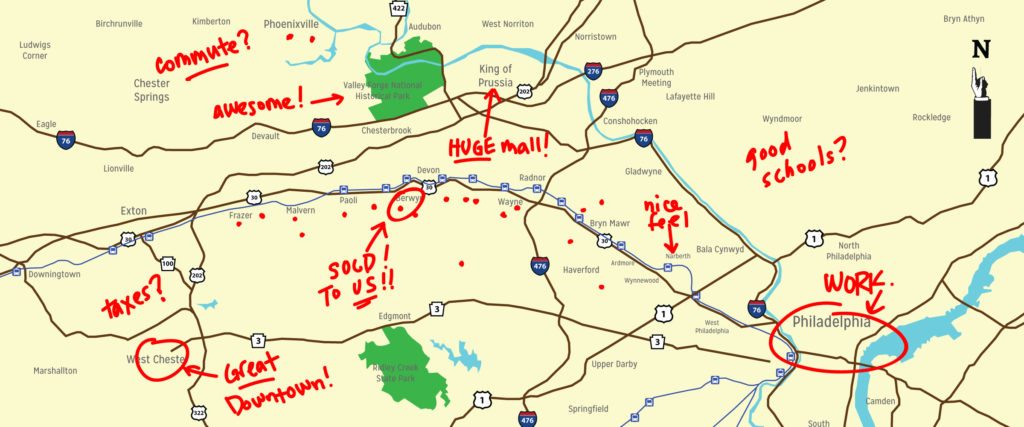
Looking for a home on Philadelphia’s Main Line?
So you’re moving to the Philadelphia suburbs and are ready to start an online home search. Sounds pretty straightforward, right? Wrong. Most people would identify towns of interest based on location, type and cost of housing, lifestyle and school district. Then, they would enter other criteria (budget, number of bedrooms and bathrooms and maybe lot size, etc.) along with the town names and, voila! A useful search is born! Or so you’d think…
Why a Main Line home search can be challenging
The reason that this approach doesn’t always yield the desired results is mostly due to the fact that Main Line towns don’t play by normal rules. Here’s what I mean: in most cases, if you live in a certain town, you know which school district your kids will attend. You have a pretty good idea of what the taxes on a property of a certain price will be.
However, many of our towns cross county lines and school district boundaries. For example, you could live in Wayne, PA and reside in Montgomery County. Or Delaware County. Or Chester County. And your school district could be Upper Merion, Radnor or Tredyffrin-Easttown. Your taxes could vary wildly, depending on exactly which township your house were located in. Finally, we have inconsistencies in our tax records that assign town names to properties that are not actual town names. Therefore. when you try to search for those towns (like Radnor or St. Davids), you get no results.
How can you focus your home search?
Confusing? Yup. So how can you be sure you’re using the wisest search parameters? Well, the easiest answer is: find a great real estate agent who will design a search for you that will limit the number of “no way” options while not filtering out all reasonable possibilities. If you are not ready to do that yet, I’d advise you to use zip codes instead of town names and, if school district matter to you, be sure to include that as a criteria. Most search engines don’t allow for that from a public-facing site, though Compass’s does.
If you don’t want to designate specific zip codes, you can also use the map drawing option to create a customized geographical boundary. Some people like to choose a location (like a work address) and click the button showing properties located within a specific distance radius of that point. Consider total square footage and lot size if those are important. You can also select whether there are attached garages or central air. You can even select home styles (or types to avoid, like split levels or ranches). My recommendation is to not be overly-restrictive when you begin; you can always tighten or tweak criteria, but you want to avoid filtering out properties that could actually work, even if they’d need some creative thinking.
Ask an expert for help
Remember that buying a house is a huge financial investment. It is also important to recognize that making a mistake as far as location, neighborhood or the house and property itself can have far-reaching negative consequences. I mentioned earlier that you would be wise to engage an agent as early as possible in the process. Going it alone would be like writing a will without consulting a lawyer. And while lawyers charge a fee, buyer agents (at least in Pennsylvania) do not, so you have nothing to lose. Please talk to a seasoned professional!
Sometimes, you have a set of parameters in your head based on the knowledge you have–but that knowledge may be incomplete. As a result, you may discover that the criteria you’re using is not likely to generate search results that show you your best options. Talk to an agent about your priorities and what is important to you. Then allow that person to ask you some questions which often leads to a revising of your original set of requirements. Happy house hunting!
If you are relocating to the Philadelphia/Main Line area, please go to my blog page and search for posts using the relocation tag. Contact me to discuss your Philadelphia area relocation! jen@jenniferlebow.com/610 308-5973


Leave a Reply